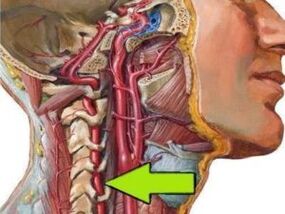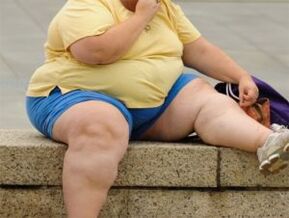Among all pathological processes that affect the spine in its different parts, cervical osteochondrosis is considered one of the most common and painful.This disease leads to a lot of complications, mainly because it affects the spinal cord and also adversely affects the brain's function.

What is cervical osteocondrosis?
The words of cervical osteocondrosis in medical practice mean an acquired progressive disease affecting the specific spine.This pathological process is characterized by degenerative-dystrophic processes in the tissues of the intervertebral disks, which are shock absorbers for the cervical vertebrae.Degenerative-dystrophic changes in the intervertebral discs are due to the fact that they are deleted and deformed.As a result of this, the distance between the vertebrae is reduced and as a result the following consequences occur:
- Narrowing the spinal cord in certain areas of the spine.
- By passing the spines - large blood vessels that supply blood supply to the brain.Due to which the supply of the brain worsens and the blood circulation in the cervical spinal cord is disturbed.
- Intervertebral discs can be deformed and flattened.This leads to pressing individual sections of the spinal cord and nerves, more often the nerve roots are pressed.
Not only do all these problems threaten a violation of the blood circulation of the brain, painful sensations in the neck, headaches, etc.According to the international classification of diseases, several separate codes were assigned osteocondrosis in the cervical region.The disease code of ICB 10 depends on the age of the disease: the disease was diagnosed:

- M02 - Dystrophy of intervertebral discs in adolescence.
- M42.12 is a dystrophic process in the neck of adults.
A lot of factors depend on the patient's age and the development rate of the pathological process, for example, consequences, complications, symptoms and of course the principles of treatment.
Causes
Knowing the causes of the development of osteocondrosis in the cervical region can play a crucial role in the diagnosis process as well as determine the principles of combating the disease.Before showing the reasons, however, it is worth saying that doctors separate two factors that lead to the development of this pathological process:
- Pathological - the destruction of the intervertebral discs and other vertebrates with the involvement of nearby tissues, blood vessels and nerve rays in the pathological process under the influence of adverse external factors.The harder these factors and other pathologies, the faster the disease develops.
- Physiologically - based on the development of pathology, mainly age -related changes.We are talking about the natural aging of cartilage tissue in the spine, salts, etc.
If we show more specific causes of cervical osteocondrosis, they are as follows:
- Violation of metabolic processes in the body as well as certain stages of obesity.
- Hypodynamia is a phenomenon characterized by a limitation of mobility.It's not just about injuries or illnesses, this can also include a sedentary lifestyle and sitting work.
- Pathologies in the cardiovascular system that contribute to reduced blood circulation in the brain, pressure changes and other things.
- Incorrect attitude, these are different forms of scoliosis, arthritis and even flat feet.
- Injection of cervical spine.In this case, we are talking about sprains, strikes, bruises.Studies of second spine in the development of cervical osteocondrosis can affect the development of cervical osteochondrosis.
- To great physical exertion in the cervical region caused by intensive sports or heavily physically difficult, depending on that kind of human activity.
- A sedentary lifestyle is also dangerous with a constant tension of the cervical spine and the whole spine if you are sitting wrong or on unpleasant furniture.
- A herd of cervix spine as well as various related diseases.
- Forced prolonged attitude of the head in an unpleasant or unnatural position.In this case, not only muscle over training occurs, but the spine is also curved in the cervical region.
- Doctors constantly consider stress and nervous overvoltage as a very common cause.
- One of the reasons is also considered congenital deviations in the spine.

What is the danger of health?
As mentioned earlier in the cervical spine, not only the spinal cord and different nerve branches are placed, but also the spinal cord arteries that supply the occipital part of the brain, cerebellum and the medullavian brain.With the development of cervical osteocondrosis, nearby tissues are paid.In addition, the development of pathology threatens to squeeze the nerve roots and transfer blood vessels, the consequences are as follows:
- Osteochondrosis is accompanied by deformations of the spine, a consequence of which the cerebrospinal canal is narrowed in certain areas.This can lead to squeezing the spinal cord and nervous branches that promise serious neurological problems.In severe cases, a person feels pain, even there is an option for loss of control over individual parts of the body (mainly in the hand or face).
- The pressure of the neck vessel, as already mentioned, is accompanied by a violation of blood circulation in the occipital area of the brain.At the same time, the brain ceases to receive oxygen and nutrients in the required quantities, oxygen -hungry begins.With circulatory disorders, there is a real risk of ischemic stroke and various neurological pathologies.
Syndromes
The main syndromes are:
- Vertebral.
- Vertebral artery.
- Koreshka.
- Heart.
It is important to know that each of these symptoms is accompanied by painful sensations of different kinds as well as a lot of unfavorable clinical signs.A person can feel dizziness, a noise appears in the ears and more.

Vertebral syndrome
It talks about the direct connection of osteocondrosis in the cervical region with bones and cartilage tissue.Symptoms in this type of pathology are also associated with the lesion of the mentioned tissue:
- The movements in the neck are partially or completely limited.
- The movements of the head are accompanied by pain in the neck.
- X -Ray shows morphological changes in the tissues (intervertebral and in the body of the vertebrae).
It is worth noting that the spine is always accompanied by these three clinical characters.If at least 1 of them are absent, the diagnosis will be completely different.
Rook Syndrome
It occurs when the roots of the spinal cord are damaged.At the same time, nervous conductivity is disturbed, a person may feel pain or lose the sensitivity of individual parts of the body or even suffer from paralysis.Depending on which of the 8 radicular couples there is a disturbance of conductivity, such symptoms are separated:
- 1 pair - numbness or pain on the back of the head;
- 3 pairs - violation of the chewing pen, numbness of the tongue and unpleasant sensations behind the ears;
- 4 pairs - pain in clavicle, violation of the swallow reflex;
- 5 pairs - violations of the shoulder band, accompanied by the problem of hand movement;
- 6 pairs - the patient begins to feel pain and numbness in the forearm and shoulder blades;
- 7 pairs - hands and fingers go numb (often index and middle);
- 8 pairs - problems similar to the previous topic, but numbness are felt in the ring finger and the little finger.
Cardial Syndrome
Despite the fact that the pathological process is still located in the cervix ridge, the syndrome has all signs of heart pathologies.The clinical image is as follows:
- Quick pulse.
- Pain in the area in the sternum.
- Shortness of breath, weakness, lethargy, decrease in performance.
Signs and symptoms of cervical osteocondrosis
For a timely search of a doctor, it is necessary to understand the signs of cervical osteocondrosis.In some cases, such knowledge allows you to seek help in the initial stages of the disease when it is easier to treat.Generally, symptoms of osteocondrosis of the cervical ridge are as follows:

- Pain for osteochondrosis is always present, only intensity and frequency are different.It is pain that is the first clinical sign.Their intensity depends on the stage of the development of the disease, in nature they are stupid or clamps.Painful sensations are mainly present in the neck of the occipital area, but can also radiate to the temporal region, shoulder bands and hands.
- In most cases, there are manifestations of the lesion in the vestibular apparatus.We are talking about frequent causal dizziness, nausea, reduced coordination of movements, uneven gait, loss in space.
- One of the most common clinical signs is the stiffness of the neck muscles and the stiffness of the movement.It is difficult for a person to turn, lower and throw your head away, movements respond with pain of pain.
- Many patients notice the feeling that goosebumps "run through the scalp" or a characteristic dot.
- In the area with the hands there is muscle weakness and numbness.
- Often there are psychological manifestations, expressed in depression, drowsiness, a sharp change in mood, temperament or irritability.
- Due to the reduced blood circulation and damage to the brain tissue, dizziness intensifies and the noise in the ears appears, similar to rattle, pulsation, ringing.
- Most patients notice visual impairment as well as pain in the eyeballs, especially when trying to cut your eyes to the left, right, up or down.
It is sometimes possible to determine the degree of development of the pathological process of symptoms.For a complete diagnosis of this, however, this is still not enough and a number of diagnostic measures are required.
Diagnostic methods
Diagnosis of osteochondrosis of the cervical spine is necessary to determine the location and stage of the development of the disease.For full diagnosis, such diagnostic methods are needed:
- X -Ray - The primary method that allows you to determine the degree and location of the deformation of the spine.
- You can use computed tomography for a more accurate diagnosis of pathological changes in the vertebrae and intervertebral discs.
- MRI (Magnetoresonance Imaging) - makes it possible to examine the wheels and vertebrae in detail, determine the presence of hernias, projections and the scale of the rest of lesions.
- Doplerography - At the same time, the study becomes the opportunity to find a place to squeeze the artery, evaluating the degree of circulatory disorders.
Treatment methods
Treatment of neck osteochondrosis always involves an integrated approach.The principles of treatment depend on the mass of factors, such as the patient's age, the stage of development of the disease, the brightness of the clinical picture, etc. Nevertheless, you cannot do without a doctor in this situation, and first and foremost you can consult a therapist who will then refer you to a vortex.As for the integrated approach: osteocondrosis of cervical osteocondrosis is treated by drug therapy, physiotherapy, massage, exercise therapy and other methods to be discussed in more detail.
Drug treatment
The basis for the treatment of cervical osteocondrosis is drug therapy involving the use of tablets, drugs and drugs in such groups:
- Anesthetics - analgesics and antispasmodics.The former directly dull nervous centers and thus stop painful sensations.The latter allows you to relieve the spasm of the neck muscles, establish blood flow and suppress pain.
- NSAIDS -AK —Steroid anti -inflammatory drugs are needed to reduce the inflammatory process, most of them also eliminate pain.Often these drugs are used in the form of gels, ointments rubbed into the affected area.
- Musorelaxants are another way to remove muscle spasm in the cervical region.
- Chondroprotectors are mandatory in certain stages of chop osteochondrosis because they contribute to the restoration of bone tissue.
- B vitamins - normalize the metabolic processes of nerve tissue, improvement of the conductivity of nerve impulses and contribute to the work of the central nervous system.
Remember that the treatment must only be performed under the supervision of a physician responsible for the appointment of each medication and determining the duration of its intake and dosage.
Physiotherapy
Treatment of neck osteochondrosis will be many times more effective using some physiotherapy techniques:

- Electrophoresis.
- Laser therapy.
- Ultrasound.
- Massage.
Massage therapy is necessarily performed by an experienced health worker, treatment is performed by a course of at least 10 sessions.Massages from the cervical region help normalize blood circulation, recover elasticity, muscle tone, relieve pain, etc.
Manual therapy
Manual therapy is based on the principle of recovering motor functions and mobility between the vertebrae.Originally, the manipulations are in a slightly relaxing massage, then fasten the doctor more and more strength, acts on the vertebrae of pressure and swing in the neck.
The use of Kuznetsov -Applicators is one of the methods of therapy for diseases of the spine, including osteochondrosis.The effect of adaptation to the cervical region normalizes metabolic processes, relieves pain, increases the muscle tone, improves blood circulation, increases conductivity in nerve tissue, etc. To prevent osteocondrosis, it is useful to engage in swimming and hang on the horizontal beam for 2-3 minutes each day.




























































































